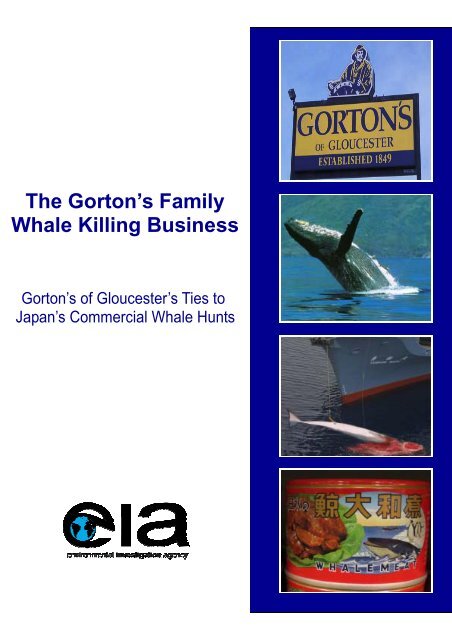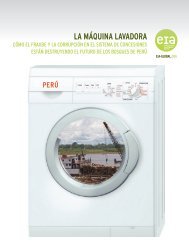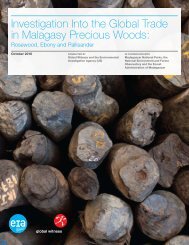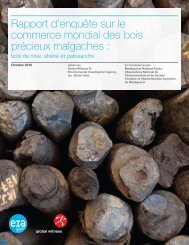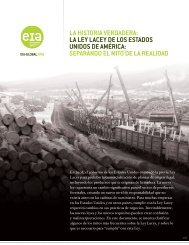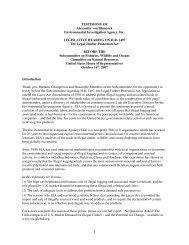The Gorton's Family Whale Killing Business - Environmental ...
The Gorton's Family Whale Killing Business - Environmental ...
The Gorton's Family Whale Killing Business - Environmental ...
Create successful ePaper yourself
Turn your PDF publications into a flip-book with our unique Google optimized e-Paper software.
CONTENTSIntroduction 1Gorton’s ties to Japanese whale hunting 2 - 3Nissui’s history of commercial whaling 4 - 7<strong>The</strong> moratorium on commercial whaling 6Nissui’s role in the decimation of sperm 8and fin whale populationsMizuho Bank—financing Japan’s whale hunts 8Nissui and the hunting of whales in the 9Southern Ocean SanctuaryJapan targets humpback and fin whales 10Conclusion 11References 11© Morgan/GreenpeaceAbove: Japanese whale hunters harpoon a minke whale in the Southern Ocean Sanctuary.
INTRODUCTION© Mia Strickland/<strong>Environmental</strong> Investigation AgencyAbove: Gorton’s of Gloucester is a wholly owned subsidiary ofNippon Suisan Kaisha Ltd. (Nissui), a company with a 70 yearhistory of whaling.INTRODUCTIONFor 70 years, the Nippon Suisan Kaisha Ltd. company ofJapan—also known as Nissui—has been involved with thelarge scale commercial hunting of great whales, whichcontinues today despite the international ban on commercialwhaling. In 2001, Nissui, through its US subsidiary NipponSuisan USA, purchased seafood giant Gorton’s, Inc. ofGloucester, Massachusetts. Gorton’s is the leading retaildistributor of frozen fish products in the US, generatingapproximately $200 million in annual revenue—the mostlucrative of all of Nissui’s overseas business segments.Nissui holds 31.9% of the shares in Kyodo Senpaku, acompany established in 1987 to continue commercial whalehunting under the guise of “scientific research”— a yearafter commercial hunts were banned by the InternationalWhaling Commission (IWC). <strong>The</strong> IWC implements theInternational Convention for the Regulation of Whaling andis the body recognized by the United Nations as having legalauthority over the world’s whales.Since 2001, when Nissui purchased Gorton’s, more than2,700 whales have been killed by Kyodo Senpaku. This ispart of the more than 175,000 whales that Nissui isresponsible for killing since it began hunting whales in the1930s. Over its long history of whaling, Nissui killed over1,700 humpback and over 44,000 fin whales, 5 contributingto their severe overhunting and consequent threatened andendangered status.Each year Nissui commercially distributes canned whalemeat from the whales harpooned by the Kyodo Senpakufleet to supermarkets and other retail outlets across Japan.<strong>The</strong> member nations of the International WhalingCommission have passed 20 resolutions calling on Japan1to reconsider its “research” hunts, but neither Nissui nor theGovernment of Japan have been dissuaded. <strong>The</strong> KyodoSenpaku whaling fleet has steadily increased the number ofwhales it kills and has expanded the species harpooned fromminkes to include Bryde’s and sperm whales. In June 2005,the Japanese government announced plans to addendangered southern hemisphere fin and threatenedhumpback whales to the growing list of great whale speciesthat Nissui and its partners in Kyodo Senpaku kill.As I write this, the Kyodo Senpaku fleet is sailing for theAntarctic <strong>Whale</strong> Sanctuary, established in 1994 withoverwhelming support by the IWC to protect great whalesfrom continued hunting. Some whale populations in theSouthern Ocean were nearly wiped out due to 20 th centurywhaling. Through its vice presidency of the Japan FisheriesAssociation, Nissui consistently supports an end to theIWC’s ban on commercial whaling. In its disregard for theinternational laws protecting whales, Nissui is also ignoringthe wishes of millions of people that patronize those Nissuicompanies that contribute to its financial success, includingthe customers of Gorton’s.As one of the largest seafood products companies in the US,Gorton’s plays an important role in the financial success ofNissui. As a wholly owned subsidiary of Nissui USA,Gorton’s of Gloucester is directly linked to Nissui’scontinued involvement in the commercial whale meat tradeand the ongoing and ever expanding hunting ofinternationally protected whales by Kyodo Senpaku.I have witnessed first hand the killing of fin, sperm andminke whales—watched as they writhed in agony on the endof a harpoon until they slowly died, their rare and preciouslives ebbing away. <strong>The</strong>ir remains are left to be transformedinto meat, shipped and sold in Japanese markets bycompanies like Nissui.Do the customers of Gorton’s of Gloucester want to supportNissui—a company that is responsible for killing more than175,000 great whales and consistently thwartinginternational laws passed to protect whales?EIA is calling on Gorton’s of Gloucester to persuade Nissuito make amends for its contribution to the destruction of theworld’s great whales by ensuring a permanent end to thewhale hunting activities of Kyodo Senpaku. We call onNissui to immediately cease all whale meat purchases, salesand distribution and to reverse its opposition to the ban oncommercial whale hunting. <strong>The</strong>se first steps by Gorton’s andNissui will begin to redress the decades of destructionwreaked on the world’s whale populations by Nissui’scommercial whale hunting.Allan Thornton, President<strong>Environmental</strong> Investigation Agency, November 2005
GORTON’S AND NISSUI© Mia Strickland/<strong>Environmental</strong> Investigation AgencyAbove: <strong>The</strong> success of Gorton’s fish sticks and other ready-to-eat products have helped Gorton’s become the number onefrozen seafood vendor in the U.S.GORTON’S LINK TO NISSUI, A COMPANY WITHA 70 YEAR HISTORY OF WHALE HUNTINGWith total annual sales in the hundreds of millions ofdollars, Gorton’s, Inc. (hereafter referred to as Gorton’s) isthe market leader of frozen seafood and fish vendors in theUnited States (US). Its frozen battered shrimp, fish sticksand other ready-to-eat foods are sold at grocery storesacross the US and Canada. <strong>The</strong> company also markets freshseafood for home delivery through its <strong>Gorton's</strong> FreshSeafood internet business, supplies frozen seafood to thefoodservice industry in the US, and produces theMcDonald’s “Filet-O-Fish ® ” sandwich.Gorton’s was founded in the New England town ofGloucester, Massachusetts in 1849 by Slade Gorton. In1906, Gorton’s merged with two other local fishingcompanies to become Gorton-Pew Fisheries Companywhich controlled the largest fleet of fishing vessels operatedby any company on the Atlantic Coast at the time. In 1995-96, Gorton’s was purchased by General Mills andsubsequently sold to Unilever's US subsidiary, UnileverUSA.Nissui USA) for $175 million. Nissui USA is a whollyowned subsidiary of Nippon Suisan Kaisha Ltd. (hereafterreferred to as Nissui), Japan’s second-largest marineproducts firm, with operations in the United States,Argentina, Chile, the Netherlands, China, Indonesia,Singapore and Vietnam.Recognizing the importance of overseas expansion, Nissuiestablished a “Toward Global Links” plan in 2001 toincrease its market share and access to fishing rightsthrough the acquisition and establishment of subsidiaries inforeign countries. Through its US subsidiary, Nissui nowowns UniSea of Redmond, Washington, FishkingProcessors of Los Angeles, BlueWater Seafoods ofMontreal and King & Prince Seafood Corporation ofBrunswick, Georgia. 1In 2001, Gorton’s was sold by Unilever to its currentowner, Nippon Suisan (USA), Inc. (hereafter referred to as2
GORTON’S AND NISSUIToday, Gorton’s is the number one brand name frozenseafood and fish vendor in the US with estimatedannual sales of around $200 million dollars. 11 In 2004,Gorton’s commanded 36.8 percent of the dollar sharein a $613 million market. Nissui’s overseassubsidiaries, particularly Gorton’s, are vitally importantto the company’s success, growth and competitive edgein the wake of increasing globalization. Gorton’s isNissui’s most profitable overseas subsidiary. 2 In itsMarch 2005 financial report, Nissui attributed its recentprofit margin increases to “…the increase in salesgenerated by the Marine Products business in the USand Europe, which offset the tough business climatefaced in Japan.” 2© David Groves/ EIAAbove: As part of its global expansion, Nissui purchasedGortons, Inc. in 2001.© Mia Strickland/EIA© Ezra Clark/EIAAbove: Nissui’s global expansion.3Above: <strong>The</strong> Nissuilogo, a red and whitetarget, can be found onits canned whale meatproducts.
NISSUI HISTORY<strong>Whale</strong>s Killed by Nissui Throughout its History<strong>Whale</strong>s Reported Killed35000300002500020000150001000050000Nissui (Antarctic)Nissui (North Pacific)Nippon Kyodo HogeiKyodo Senpaku1934-391940-441945-491950-541955-591960-641965-691970-751976-791980-861987-891990-941995-992000-05Season© ABC News-Video Source © ABC News-Video Source© ABC News-Video Source © ABC News-Video SourceAbove: A Japanese whale hunter harpoons a minke whale in the Antarctic in the 1940s. Nissui began hunting whalesunder its current brand name in the 1930s.5
WHALING BANTHE MORATORIUM ON COMMERICAL WHALINGDuring the 20 th century, the commercial whaling industry decimatedwhale populations across the globe. In an attempt to manage thewhaling industry, the International Convention for the Regulation ofWhaling (ICRW) was agreed in 1946 and the International WhalingCommission (IWC) was established. <strong>The</strong> Convention was signed andratified by all the major whaling nations.Repeated attempts by the IWC to control commercial hunting throughquota and size restrictions failed and by the 1970s most species ofgreat whale had been catastrophically depleted. In 1982, the IWCagreed to a moratorium on all commercial whaling to take effect in1986, setting zero catch quotas for all the great whales listed under theICRW. In support of the moratorium, the Convention on InternationalTrade in Endangered Species (CITES) also banned international tradein the products of all the great whale species that were not alreadyfully protected under CITES.<strong>The</strong>se conservation measures remain in place today, even withcontinued whaling by Japan, Norway and Iceland. Japan’s thinlydisguised commercial whaling operation has drawn repeated criticismfrom the IWC, including 20 resolutions, all of which have beensupported by the United States government, specifically requestingJapan to reconsider its special permit research. 6PicturedBlue whaleFin whaleSperm whaleRight whaleSei whaleHumpback whaleGray whaleMinke whaleNot picturedBowhead whaleBryde’s whalePygmy right whaleNISSUI’S COMMERCIAL WHALE HUNTINGAFTER THE MORATORIUMDespite the international ban on commercial whaling,Gorton’s parent company, Nissui, the Maruha Group, Ltd.(through its subsidiary Taiyo A&F Co. Ltd.) and KyokuyoCo, Ltd., continue to engage in the large scale hunting ofwhales. In collaboration with the Japanese government,these companies have devised an elaborate but transparentscheme to maintain Japan’s commercial whaling industryand market for whale products, while portraying their whalehunting as “scientific research.”In 1987, just one year after the moratorium on commercialwhaling went into effect, Nippon Kyodo Hogei Co. Ltd. wasdissolved and its assets were transferred to a new company,Kyodo Senpaku Kaisha Ltd., a vessel and crew chartercompany. 22,29 Nissui, Kyokuyo and Maruha maintainednearly the same division of ownership in Kyodo Senpaku(roughly one-third each) as they held in Nippon KyodoHogei Co., Ltd.In the same year, the Government of Japan, through theFisheries Agency of the Ministry of Agriculture, Forestryand Fisheries, established the Institute of Cetacean Research(ICR) and issued it with a special permit to kill whales forscientific research in the Antarctic. <strong>The</strong> ICR is a non-profitbody which is subsidized by the Government of Japan, andalso receives support from the Japan Whaling Association, aprivate trade body which lobbies intensively for the lifting ofthe moratorium on commercial whaling. 23,246<strong>The</strong> ICR and Japan’s Fisheries Agency contract exclusivelywith Kyodo Senpaku to carry out the Antarctic and NorthPacific “research” whale hunts. ICR then manipulates thepricing and distribution of Kyodo Senpaku’s catch. Uponcompletion of its “research,” the ICR consigns KyodoSenpaku to sell a portion of the catch to licensed consigneesat wholesale markets in various major cities, at prices set bythe ICR. For this service Kyodo Senpaku receives a 5.5%commission. <strong>The</strong> consignees then sell the products tobrokers at the same price, for which they receive a 5.5%commission. 29 <strong>The</strong> ICR also distributes portions of the catchat a reduced cost to public institutions, including schools,and local governments to promote whale consumption. 4,30 Inaddition, Nissui and Kyokuyo purchase a portion of thecatch, which they process and sell to their retail customersunder their own brand names. 30 After payment of thecommissions, all monies revert to ICR. 30Far from being an independent research organization, theICR is entirely dependent on the Government of Japan’ssubsidies and issuance of special permits to carry out its“research.” Various reports indicate that the FisheriesAgency subsidizes the ICR with anywhere between $8million and $73 million per year. 23,28 <strong>The</strong>se subsidies havebeen necessary for the hunt to date, since the sale ofproducts from the “scientific” hunt have not covered theentire costs of the “research”. However as the Governmentof Japan expands the hunt in the Antarctic and assuming thatthe Government of Japan’s efforts to promote whaleconsumption are successful, it is likely that profits fromselling the meat will far exceed the costs of the research.
WHALE HUNTING© Morgan/Greenpeace<strong>The</strong> ICR and Kyodo Senpaku are closely linked, for examplethe current President of Kyodo Senpaku was previouslyemployed as General Manager of ICR. 3 Despite posing as anon-profit research institution, the ICR plays a key role inlobbying for the resumption of commercial whaling andinfluencing the domestic market for whale meat in Japan.Kyodo Senpaku is also dependent on the Japanesegovernment, along with its key shareholders, to remainviable. While the Japanese government has no legal controlor ownership over Kyodo Senpaku, the ICR and the JapanFisheries Agency are its sole clients and the latter has evenloaned Kyodo Senpaku money to build a new whalingvessel. 3 This is in addition to a series of long-term loans thatKyodo Senpaku has received from the Agriculture, Forestryand Fisheries Department and private banks, such as MizuhoBank, totaling more than $14 million. 3 <strong>The</strong> terms ofrepayment for these loans are unclear.Nissui, Kyokuyo and Maruha have maintained their ties towhaling as majority shareholders in Kyodo Senpaku, theformer two companies still owning roughly one-third of theshares. Although Maruha sold its one-third share in 1999,19% of the shares were sold to a Maruha subsidiarycompany, Taiyo A&F Co Ltd. 22 Nissui and Kyokuyocontinue to commercially sell and distribute whale meatproducts across Japan.<strong>The</strong> involvement of the large fisheries corporations in the socalledgovernmental research is clearly with a view to future© Greenpeace © Greenpeace © Greenpeacelarge-scale commercial whaling. <strong>The</strong> President of Nissui,Naoya Kakizoe, and the President of Maruha, Yuji Igarashi,are both Vice Presidents of the Japan Fisheries Association, anon-government organization that routinely lobbies for liftingthe moratorium on commercial whaling at meetings of theIWC. 10According to the Mainichi Shimbun Newspaper, a formeremployee of the Fisheries Agency, Dr. Toshio Kasuya,publicly criticized Japan’s scientific whaling as “…nothingother than an economic activity.” <strong>The</strong> respected marinemammal biologist noted that: “<strong>The</strong> annual expenses of theresearch program amount to around 6 billion yen, or morethan $50 million, of which 5 billion yen is covered by thesales of whale meat produced from the catch by the scientificwhaling. Government subsidy and other-funding make up theremaining 1 billion yen. Without the earnings from the meatsales, the whaling organization that undertakes thegovernment-commissioned research program would beunable to continue operation, and the shipping company thatprovides the fleet for the program would not be able torecover costs for whaling vessel construction. This is nothingother than an economic activity. It leaves no room forresearchers to carry out research based on their own ideas. Itcertainly does not conform to the scientific purposeauthorized by the Convention.”<strong>The</strong>refore, despite decreasing demand for whale meat inJapan and the decision by several large retailers todiscontinue the sale ofwhale meat in their stores,the Government of Japan,in collusion with Nissui,Kyokuyo and Maruha,keeps the whalingindustry afloat, buyingtime while they work tooverturn the moratorium.Left: Japanese“research” whalehunters kill andfilet a minke whalein the SouthernOcean Sanctuary.7
MIZUHO BANKMIZUHO BANKFINANCING JAPAN’S WHALE HUNTSKyodo Senpaku’s main creditor is Mizuho Bank Ltd.(Mizuho), an international bank with offices across theglobe including North America, Europe and the MiddleEast. Mizuho is considered one of the world’s leadinginvestment banks, ranked first in the world in terms ofassets in 2003.Mizuho Corporate Bank, a subsidiary of Mizuho BankLtd., provides both long-term loans of up to 1.6 billionyen (US$14 million) for investment in fixed assets aswell as annual short-term loans up to 1.1 billion yen(nearly US$10 million) to Kyodo Senpaku, 3 directlyfinancing the killing of hundreds of whales each year.© D.Sims/EInvironmental Invrestigation AgencyNISSUI’S ROLE IN THE DECIMATION OF SPERM AND FIN WHALE POPULATIONSDuring the first half of the 20 th century, sperm whale oil was a highly lucrative trade. 21 A total of 258,000 sperm whales werereported to have been killed by commercial whalers operating in the North Pacific between 1947 and 1987, not includingunreported catches by the USSR’s deep sea operations. Of the 258,000 sperm whales reportedly taken during the period1947-87, almost half were reported killed by Japanese whalers. Of these, Nissui reported taking over a quarter, around32,500 sperm whales—more than all other great whales taken by the company in the North Pacific during this time. 5Between 1966 and 1970, Nissui reported killing 8,500 sperm whales in the North Pacific. 5 Abundance of sperm whales in theNorth Pacific was reported to be 1,260,000 prior to exploitation, which by the late 1970s was estimated to have been reducedto 930,000 whales. <strong>The</strong>re is no current abundance estimate for sperm whales in the northwestern Pacific. Sperm whales arenotoriously difficult to derive abundance estimates for and it is unclear how well the populations are recovering.<strong>The</strong> most recent data collated by the IWC shows that around 682,000 fin whales were reportedly killed in Antarctic watersbetween 1905 and 1975. 5 Nissui is responsible for over40,000 of these deaths, accounting for over a third of allfin whales killed by the Japanese in the Antarctic. 5 At theheight of Japanese whaling in the Antarctic, between1954 and 1958, around 30,000 fin whales were killed byJapanese whaling companies, with Nissui responsible forsome 12,000 of these deaths. 5In 1955 the IWC estimated the Antarctic fin whale stockto be approximately 120,000 animals, depleted from anestimated population size of 400,000 in 1900. <strong>The</strong> effortsof the whalers further diminished the population toaround 85,000 by 1978. <strong>The</strong> IWC’s Scientific Committeedoes not currently offer any population abundanceestimate for southern hemisphere fin whales, although apaper presented to the 46 th meeting of the IWC’sScientific Committee estimated the Southern Hemispherefin whale population to be less than 18,000.Credit: NOAA/US Department of Commerce8
SOUTHERN OCEANSANCTUARYNISSUI AND THE HUNTING OFWHALES IN THE SOUTHERNOCEAN SANCTUARYWhen Nissui helped establish KyodoSenpaku as a charter company in 1987 inresponse to the moratorium on commercialwhaling, the Government of Japan issuedthe company with special permits to killminke whales in the Antarctic SouthernOcean. Since 1987, Nissui and its partnersthrough Kyodo Senpaku have killed nearly7,000 Antarctic minke whales. 4© Mia Strickland/<strong>Environmental</strong> Investigation Agency© Mia Strickland/EInvironmental Investigation AgencyAbove: Nissui brand canned whale meat on sale at a supermarket in Japan.In 1994, the IWC voted by a majority of 23to 1 to designate the entire Southern Oceanas a whale sanctuary. In spite of almostuniversal support for the Southern OceanSanctuary within the IWC, Japan registeredan objection to the designation regardingminke whales, while accepting that itapplied to all other species of whalesincluding fin and humpback whales. In thesame year, the Government of Japanauthorized the expansion of its ‘”research”hunt to include minke whales in the PacificOcean while continuing its Antarctic huntand expanding the number of minkescaught, despite its designation as an IWCsanctuary.<strong>The</strong>re is now concern regarding the statusof Antarctic minke whales. Recentabundance estimates reported by the IWCScientific Committee suggest that thewhale population may have suffered aprecipitous decline over the last decade, oralternatively that consecutive abundancesurveys have not been comparable,rendering population estimates unreliable.Since 1987, Nissui andits partners throughKyodo Senpaku havekilled nearly 7,000Antarctic minke whalesin the Southern OceanSanctuary. 49
HUMPBACK & FINWHALESCredit: National Oceanic and Atmospheric Administration/U.S. Department of CommerceAbove: At the June meeting of the International Whaling Commission, the Japanese government announced plans to “broaden”its annual hunt to include endangered Antarctic fin and humpback whales.JAPAN TARGETS THREATENED HUMPBACK ANDENDANGERED FIN WHALESAt the June 2005 meeting of the IWC, despite strongobjections from the international community including thegovernments of the US, UK, Australia and New Zealand, theJapanese government announced plans to “broaden” its annualhunt to include endangered Antarctic fin whales andhumpback whales. Under a newly revised “scientific”whaling program “JARPAII”, Japanese hunters will kill 50humpbacks and 50 fin whales per year in addition to up to 935Antarctic minke whales. 7Humpback and fin whale populations were severely depletedby commercial whaling during the first half of the 20thcentury. Historic whaling records show Nissui to beresponsible for the death of over 44,000 fin whales and over1,700 humpbacks prior to the moratorium on commercialwhaling. 5watching industry, a recreational activity enjoyed by over 9million people in 87 countries and territories. Precise estimatesof fin whale populations in the Southern Ocean are unknown,however they are listed as endangered by the WorldConservation Union. 47In addition to its recent decision to hunt Antarctic humpbackand fin whales, the Japanese government also annually huntssperm whales, sei whales and Bryde’s whales in the NorthPacific. <strong>The</strong> Government of Japan also issues catch quotas formore than 22,000 coastal dolphins, porpoises and smallwhales each year, with the products sold for humanconsumption in commercial markets across Japan.Humpback whales are thought to number as few as 10,000 inthe southern hemisphere and are listed as vulnerable by theWorld Conservation Union (IUCN). <strong>The</strong>se charismaticcreatures form the backbone of the billion dollar-a-year whale10
CONCLUSION &REFERENCESCONCLUSIONEIA is calling on the President & CEO of Gorton’s topersuade its parent company, Nissui, to bring an end to thehunting of the world’s great whales by permanently shuttingdown the Japanese fleet.hunting whales for commercial purposes. This arrangementalso allows the companies and the government to maintain aviable whaling fleet until they are able to overturn themoratorium.Since 1986, the Government of Japan, with the assistance ofcompanies such as Nissui, has engaged in large scale whalehunting for commercial purposes in direct contravention ofinternational law. <strong>The</strong> Government of Japan has continuallyignored the decisions and recommendations of the IWC andhas actively worked with the whaling companies to have themoratorium on commercial whaling lifted.To provide rationale for maintaining the whaling industry inspite of the moratorium, the Japanese government created theInstitute of Cetacean Research to hunt whales for “scientific”purposes. To keep the whaling industry afloat in the face ofever decreasing consumer demand, the governmentmanipulates the market for whale meat and subsidizesKyodo Senpaku. Behind this artifice, Nissui and otherwhaling companies are able to continue to market largevolumes of whale meat, despite the international ban onAs a multinational conglomerate that depends on access toforeign markets and fisheries, Nissui has a responsibility toits international constituency, which is overwhelmingly insupport of the protection of whales from commercialhunting.It is time for Nissui to make amends for its long and bloodyhistory of whale hunting and its contribution to thedecimation of the world’s great whales. Gorton’s is Nissui’smost profitable overseas subsidiary and a critical componentin its plan for global expansion. As such Gorton’s is wellpositioned to influence Nissui to respect the wishes of itsinternational constituency. EIA strongly urges Gorton’s touse its connections with Nissui to bring an end to theongoing slaughter of whales by Japan.REFERENCES1. <strong>The</strong> History of Nissui. Nissui web site. Internet. November 25, 2005. http://www.nissui.co.jp/english/top.html.2. Nippon Suisan Kaisha, Ltd. Summary of Financial Statements for the year Ended March 31, 2005.3. Confidential personal communication to Danielle Grabiel. April 2005.4. Special Permit Catches (JARPA & JARPN offshore) since 2001 according to Japanese progress reports to theIWC Scientific Committee and the JWA News No 12, Sept 2005: 2001- 599; 2002-684; 2003-650; 2004-643;2005-255.5. IWC whaling records International Whaling Commission individual catch database version 2, October 2005,courtesy of C. Allison; and International Whaling Commission historical catch database: Antarctic humpbackwhale catches by expedition 1904—1972; Antarctic fin whale catches by expedition 1904—1975. Accessed15 th March 2005, courtesy C. Allison.6. 1987:4 Resolution on Japanese Proposal for Special Permits1989:3 Resolution on the Proposed Take by Japan of <strong>Whale</strong>s in the Southern Hemisphere under SpecialPermit1990:2 Resolution on Special Permit Catches by Japan in the Southern Hemisphere1991:2 Resolution on Special Permit Catches by Japan in the Southern Hemisphere1992:5 Resolution on Special Permit Catches by Japan in the Southern Hemisphere1993:7 Resolution on Special Permit Catches by Japan in the Southern Hemisphere1994:9 Resolution on Special Permit Catches by Japan in the North Pacific1994:10 Resolution on Special Permit Catches by Japan in the Southern Hemisphere1996:7 Resolution on Special Permit Catches by Japan1997:5 Resolution on Special Permit Catches by Japan in the Southern Ocean by Japan1997:6 Resolution on Special Permit Catches in the North Pacific by Japan1998: 4 Resolution on Whaling Under Special Permit1999:3 Resolution on Whaling Under Special Permit2000:4 Resolution on Whaling under Special Permit in the Southern Ocean Sanctuart2000:5 Resolution on Whaling under Special Permit in the North Pacific Ocean2001:7 Resolution on Southern Hemisphere Minke <strong>Whale</strong>s and Special Permit Whaling2001:8 Resolution on Expansion of JARPNII Whaling in North Pacific2003:2 Resolution on Whaling under Special Permit2003:3 Resolution Southern Hemisphere minke whales and special permit whaling2005:1 Resolution on JARPAII7. Report of the Scientific Committee. International Whaling Commission meeting 57. IWC/57/REP1.8. Japanese whalers leave port for Antarctic. <strong>The</strong> Age. November 8, 2005.9. For examples see: IWC/55/OS JFA and IWC/56/OS JFA and IWC/56/OS Japan.; and Executive Organization.Fisheries Association web site. Internet. November 25, 2005. http://www.suisankai.or.jp.10. Wishnow, Sharon J. Baby Boomers, Health, Ethnic Trends Help Spur Frozen Seafood Innovation. Quick FrozenFoods International feature article. January 2005.11. <strong>The</strong> Gorton’s Team. Gorton’s web site. Internet. November 25, 2005; and Mc Donald’s Product Information:http://www.media.mcdonalds.com. Internet November 25, 2005.12. Our Story.Gorton’s web site. Internet. http://www.gortons.com. November 25, 2005.13. MIT Sea Grant: New England’s Fishing Communities. County Profiles, Gloucester/North Shore sub-region,Essex County, Section 5.6.1. 2004.14. Operations and Strategy. Unilever web site. Internet. November 25, 2005. http://www.unilever.com.15. Investor Releations. Nissui web site. Internet. November 25, 2005. http://www.nissui.co.jp/english.16. Hoovers Fact Sheet for Nippon Suisan Kaisha, Ltd. 2005.17. Values and Vision.Nissui web site. Internet. November 25, 2005. http://www.nissui.co.jp/english.18. Notice of Acquisition of Frozen Seafood Producer (King & Prince Seafood Corp.) in USA. Nissui Letter.July 2, 2005.19. Garrison, Bob. See Food Differently. Refrigerated & Frozen Foods Online Magazine. August 2004; andUnited Fishermen of Alaska Update. August 17, 2001.20. Tonnassesn, J.N. & Johnsen, A.O. <strong>The</strong> History of Modern Whaling. 1982.21. Furukawa, K., Japan Whaling Association, ‘ISANA’ 2004.22. History of Japanese Commercial Whaling.<strong>Whale</strong> and Dolphin Conservation Society web site. Internet.November 25, 2005. http://www.wdcs.org.23. Russell, Dick. Whaling. <strong>The</strong> Ecologist. 2002.24. National Marine Fisheries Service (NOAA) Sperm whale North Pacific stock (NOAA-TM-AFSC-144).Revised 1/5/2003. cites pers. comm. with C. Allison, International Whaling Commission.25. Rice, D. W. 1989. Sperm whale, Physeter macrocephalus. Pp. 177-233, In S. H. Ridgway and R Harrison(eds.), Handbook of Marine Mammals. vol 4. River Dolphins and the Larger Toothed <strong>Whale</strong>s. AcademicPress, New York26. Anon, Final Report of the Committee of Three Scientists. Report to the International Whaling Commission,1964.27. Gambell, R. (Secretary to the IWC), <strong>Whale</strong>s in the Antarctic ecosystem. Environment International, 1987.28. Butterworth, D.S., Borchers, D.L., Chalis, S. and De Decker, J.B. 1995. Estimates of Abundance for SouthernHemisphere Blue, Fin, Sei, Humpback, Sperm, Killer and Pilot <strong>Whale</strong>s From the 1978/79 to 1990/91IWC/IDCR Sighting Survey Cruises, With Extrapolations to the Area South of 30ºS for the First Five SpeciesBased On Japanese Scouting Vessel Data. Report SC/46/SH24.29. Institute of Cetacean Research, <strong>The</strong> standards of the sale and handling of by-products of cetacean research huntingproject, amendment Sept 2001.30. Confidential communication to Clare Perry. November 17, 2005.31. For example, on 21 st Dec 2004, ICR hosted a seminar on whalemeat to lobby the Japan Chain Store Association,which purchases fishery products for supermarkets, regarding the safety and nutritional value ofwhale meat. Suisan Keizai Shinbun December 22 nd , 2004.32. 26 April 2002: Asahi Shimbun article. Changing tastes may sink whaling fleet.33. EIA telephone surveys of five leading supermarket chains in Japan, 2001-2005.34. <strong>The</strong> Mainichi Shinbun Newspaper. October 3, 2005.35. Several large Japanese retailers, including Tesco and Ito Yokado, have stopped selling whale meat in theirstores with a few small exceptions.36. Global Banking Statistics 2003. Published in <strong>The</strong> Tax Glossary.37. International Convention for the Regulation of Whaling, 1946. Schedule Para 10(e): Nothwithstanding theother provisions of paragraph 10, catch limits for the killing for commercial purposes of whales from allstocks for the 1986 coastal and the 1985/6 pelagic seasons and thereafter shall be zero.38. Frost, Sir Sydney, <strong>The</strong> Whaling Question. June 1979.39. For CITES Appendix I listings of whale species, see the CITES web site. Internet. http://www.cites.org.40. ABC News Online, Humpback <strong>Whale</strong> Population on the Rise, August 31, 2005.41. World Conservation Union Red List. Internet. http://www.iucn.org.42. International Fund for Animal Welfare, Worldwide Tourism Numbers, Expenditures,and Expanding SocioeconomicBenefits, special report, August 2001.43. National Research Institute of Far Seas Fisheries. Japan Progress Report on Small Cetacean ResearchesApril 2003 to April 2004. Japan Progrep SM200444. Chairman’s report of the 46 th Annual Meeting of IWC 12. <strong>Whale</strong> Sanctuary in the Southern Ocean, pp 21-24.45. Section 10.2. Southern Hemisphere minke whales. (2001) Journal of Cetacean Research and Management 3(supplement). Pp 29-32.11
ACKNOWLEDGEMENTSThis report was written and researched by DanielleFest Grabiel, Clare Perry, Claire Bass and AllanThornton. Picture research by Tom Thistlethwaiteand Danielle Grabiel. Additional editing by DavidGroves.Special thanks to the Humane Society of the UnitedStates for its support of the printing of this report.Thanks also to our colleagues at Greenpeace for theirphotos and comments on the text.Front cover photos:Gorton’s sign: © Mia Strickland/<strong>Environmental</strong>Investigation Agency, Nissui canned whale meat: ©Mia Strickland/<strong>Environmental</strong> Investigation Agency,Humpback whale photo: National Oceanic andAtmospheric Administration/U.S. Department ofCommerce, Harpooned minke whale: © Morgan/<strong>The</strong> <strong>Environmental</strong> Investigation Agency (EIA) isan inependent, international campaigningorganization committed to investigation andexposing environmental crime. Since 1984, EIAhas used pioneering investigative techniques allover the world to expose the impact ofenvironmental crime and to seek lasting solutions.EIA’s aims are to: Gain lasting protection for species under threat;Protect the shared environment of man andwildlife; and Stop illegal trade in endangered species.USPO Box 53343Washington , DC 20009Tel +1 202 483 6621Fax +1 202 986 8626Email: usinfo@eia-international.orgwww.eia-international.orgUK62-63 Upper StreetLondon N1 ONYUnited KingdomTel +44 (0)20 7354 7960Fax +44 (0)20 7354 7961info@eia-international.org


